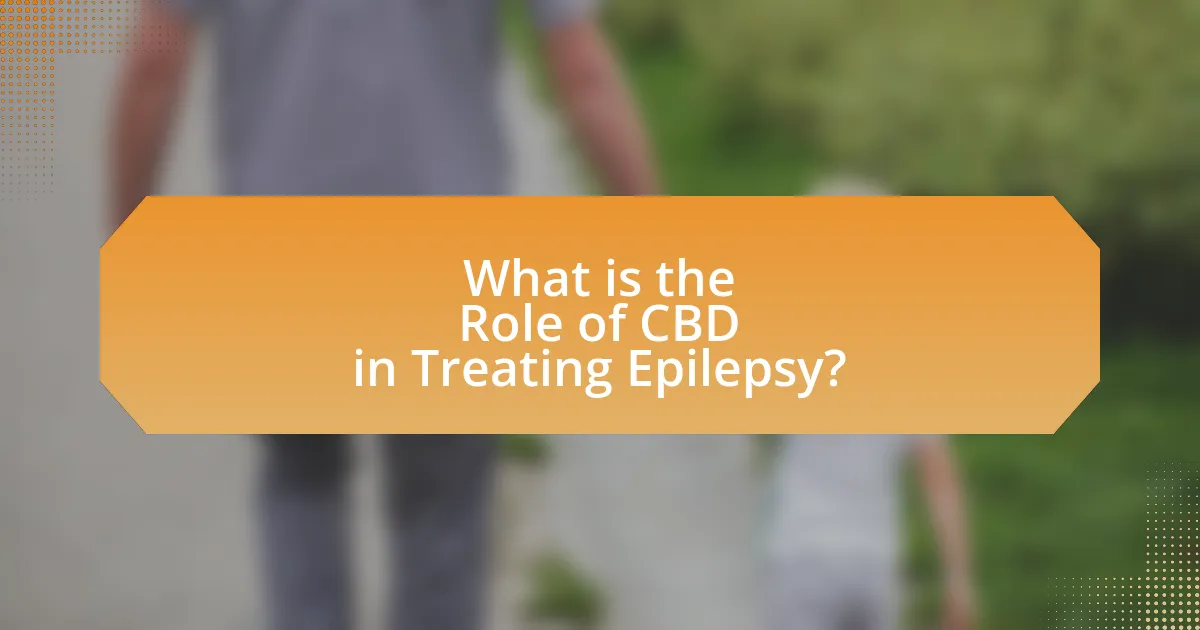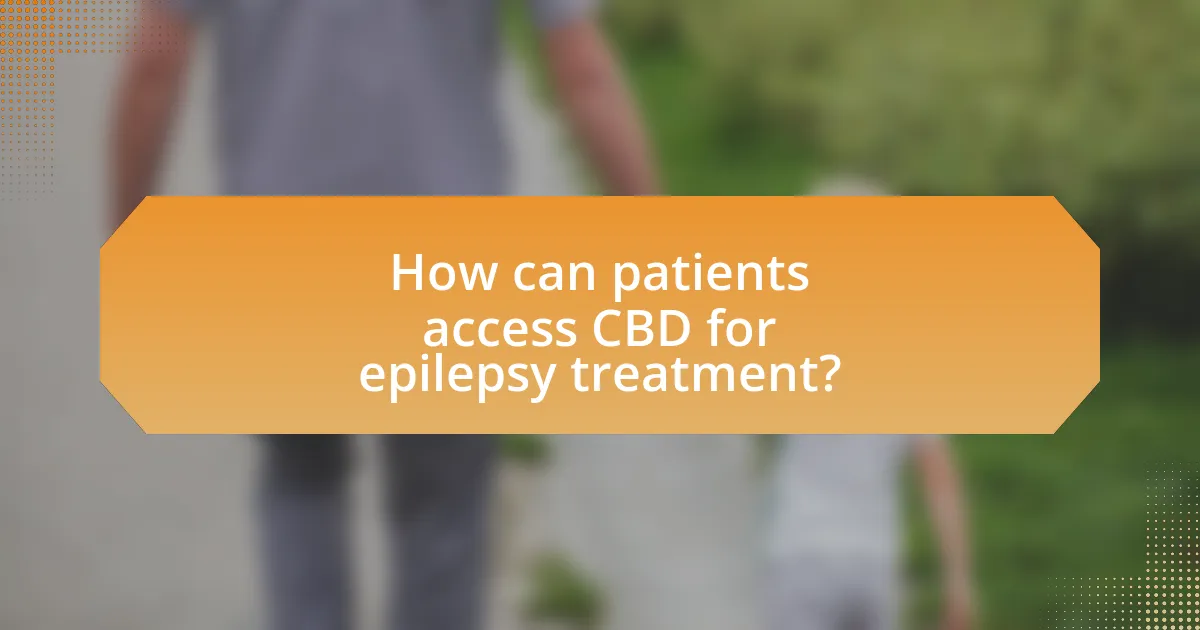The article examines the role of cannabidiol (CBD) in treating epilepsy, particularly focusing on its effectiveness in reducing seizures in treatment-resistant forms such as Dravet syndrome and Lennox-Gastaut syndrome. It highlights clinical trial findings, including significant reductions in seizure frequency and the FDA’s approval of Epidiolex, a CBD-based medication. The article also explores the interaction of CBD with the endocannabinoid system, its mechanisms of action, potential side effects, and the legal considerations surrounding its use. Additionally, it provides guidance for patients on accessing CBD and integrating it into their existing treatment plans.

What is the Role of CBD in Treating Epilepsy?
CBD plays a significant role in treating epilepsy by reducing the frequency and severity of seizures in certain types of epilepsy, particularly in treatment-resistant forms such as Dravet syndrome and Lennox-Gastaut syndrome. Clinical trials, including a pivotal study published in the New England Journal of Medicine, demonstrated that CBD significantly reduced the number of seizures in patients compared to a placebo, with some patients experiencing a reduction of up to 50% in seizure frequency. The FDA has approved Epidiolex, a CBD-based medication, specifically for these conditions, underscoring its efficacy and safety profile in managing epilepsy.
How does CBD interact with the endocannabinoid system in relation to epilepsy?
CBD interacts with the endocannabinoid system (ECS) by modulating cannabinoid receptors, particularly CB1 and CB2, which play a crucial role in regulating neuronal excitability and neurotransmitter release. This interaction helps to reduce the frequency and severity of seizures in epilepsy patients. Research indicates that CBD enhances the levels of anandamide, an endocannabinoid, which can further contribute to its anticonvulsant effects. A study published in the New England Journal of Medicine demonstrated that CBD significantly reduced seizure frequency in patients with Dravet syndrome, a severe form of epilepsy, highlighting its therapeutic potential in managing epilepsy through ECS modulation.
What are the key components of the endocannabinoid system involved in seizure regulation?
The key components of the endocannabinoid system involved in seizure regulation are endocannabinoids, cannabinoid receptors, and enzymes. Endocannabinoids, such as anandamide and 2-arachidonoylglycerol, are naturally occurring lipids that bind to cannabinoid receptors, primarily CB1 and CB2, which are distributed throughout the central nervous system and peripheral tissues. These receptors modulate neurotransmitter release and neuronal excitability, influencing seizure activity. Enzymes like fatty acid amide hydrolase and monoacylglycerol lipase are responsible for the synthesis and degradation of endocannabinoids, thereby regulating their availability and activity in the brain. Research indicates that the activation of CB1 receptors can inhibit excitatory neurotransmitter release, providing a mechanism for seizure suppression.
How does CBD influence neurotransmitter activity related to epilepsy?
CBD influences neurotransmitter activity related to epilepsy primarily by modulating the endocannabinoid system, which plays a crucial role in regulating neuronal excitability and neurotransmitter release. Research indicates that CBD enhances the levels of anandamide, an endocannabinoid that can inhibit excessive neuronal firing, thereby reducing seizure activity. A study published in the New England Journal of Medicine demonstrated that CBD significantly reduced the frequency of seizures in patients with Dravet syndrome, a severe form of epilepsy, highlighting its impact on neurotransmitter modulation. Additionally, CBD has been shown to interact with serotonin receptors, which may further contribute to its anticonvulsant effects.
What types of epilepsy can potentially benefit from CBD treatment?
Certain types of epilepsy that can potentially benefit from CBD treatment include Dravet syndrome and Lennox-Gastaut syndrome. Clinical studies have demonstrated that CBD can significantly reduce the frequency of seizures in patients with these specific forms of epilepsy. For instance, a study published in the New England Journal of Medicine in 2017 showed that CBD reduced the monthly frequency of seizures by 50% or more in approximately 43% of patients with Dravet syndrome. This evidence supports the efficacy of CBD in managing these severe epilepsy types.
Which specific epilepsy syndromes have shown positive responses to CBD?
The specific epilepsy syndromes that have shown positive responses to CBD include Dravet syndrome and Lennox-Gastaut syndrome. Clinical studies have demonstrated that CBD can significantly reduce the frequency of seizures in patients with these syndromes. For instance, a study published in the New England Journal of Medicine in 2017 reported that CBD reduced drop seizures by 43% in patients with Lennox-Gastaut syndrome. Additionally, another study indicated that patients with Dravet syndrome experienced a notable decrease in seizure frequency when treated with CBD.
How do different types of seizures respond to CBD therapy?
Different types of seizures respond variably to CBD therapy, with significant efficacy observed particularly in treatment-resistant epilepsy forms such as Dravet syndrome and Lennox-Gastaut syndrome. Clinical trials, including a pivotal study published in the New England Journal of Medicine, demonstrated that CBD reduced the frequency of seizures in patients with these conditions by approximately 50% compared to placebo. Additionally, CBD has shown promise in alleviating seizures associated with other epilepsy syndromes, although responses can differ based on individual patient factors and seizure types.
What recent advances have been made in CBD research for epilepsy treatment?
Recent advances in CBD research for epilepsy treatment include the FDA approval of Epidiolex, a CBD-based medication specifically for treating Dravet syndrome and Lennox-Gastaut syndrome, two severe forms of epilepsy. Clinical trials have demonstrated that Epidiolex significantly reduces the frequency of seizures in patients, with studies showing a reduction of up to 50% in seizure frequency for some individuals. Additionally, ongoing research is exploring the efficacy of CBD in combination with other antiepileptic drugs, which may enhance treatment outcomes.
What clinical trials have demonstrated the efficacy of CBD in epilepsy?
Clinical trials have demonstrated the efficacy of CBD in epilepsy, particularly in the treatment of Dravet syndrome and Lennox-Gastaut syndrome. The pivotal trial published in the New England Journal of Medicine in 2017, led by Devinsky et al., showed that CBD significantly reduced the frequency of seizures in patients with Dravet syndrome, with a median reduction of 39% compared to placebo. Another study, also published in the same journal, focused on Lennox-Gastaut syndrome and reported a 42% reduction in drop seizures with CBD treatment. These trials provided substantial evidence supporting the use of CBD as an effective treatment option for specific types of epilepsy.
How have regulatory changes impacted CBD research and availability for epilepsy?
Regulatory changes have significantly enhanced CBD research and availability for epilepsy by facilitating clinical trials and increasing access to CBD products. The 2018 Farm Bill in the United States legalized hemp-derived CBD, which led to a surge in research funding and interest in its therapeutic potential for epilepsy. This legislative shift allowed for the development and approval of CBD-based medications, such as Epidiolex, which received FDA approval in 2018 for treating certain types of epilepsy. The approval was based on clinical trials demonstrating its efficacy in reducing seizure frequency, thus validating the impact of regulatory changes on both research and patient access to CBD treatments.

What are the mechanisms by which CBD may reduce seizures?
CBD may reduce seizures through several mechanisms, including modulation of neurotransmitter release, interaction with cannabinoid receptors, and reduction of inflammation. Specifically, CBD influences the endocannabinoid system by enhancing the levels of anandamide, a naturally occurring cannabinoid, which can lead to decreased excitability of neurons. Additionally, CBD has been shown to inhibit voltage-gated sodium channels, which can stabilize neuronal membranes and prevent excessive firing that leads to seizures. Research published in the New England Journal of Medicine by Devinsky et al. in 2017 demonstrated that CBD significantly reduced seizure frequency in patients with Dravet syndrome, providing clinical evidence of its efficacy in seizure management.
How does CBD affect neuronal excitability and seizure threshold?
CBD reduces neuronal excitability and increases seizure threshold. Research indicates that CBD modulates the endocannabinoid system, particularly by enhancing the activity of GABA receptors, which are crucial for inhibitory neurotransmission. A study published in the journal “Epilepsia” by Devinsky et al. (2017) demonstrated that CBD administration led to a significant reduction in seizure frequency in patients with treatment-resistant epilepsy, supporting the notion that CBD can effectively alter neuronal excitability and improve seizure control.
What role do CBD’s anti-inflammatory properties play in seizure reduction?
CBD’s anti-inflammatory properties contribute to seizure reduction by modulating neuroinflammation, which is often implicated in seizure activity. Research indicates that inflammation in the brain can exacerbate seizure frequency and severity, and CBD has been shown to reduce markers of inflammation, thereby potentially stabilizing neuronal activity. A study published in the journal “Epilepsia” demonstrated that CBD administration led to a significant decrease in seizure frequency in patients with treatment-resistant epilepsy, suggesting that its anti-inflammatory effects may play a crucial role in this therapeutic outcome.
How does CBD modulate calcium channels in neurons?
CBD modulates calcium channels in neurons primarily by interacting with voltage-gated calcium channels, leading to a reduction in calcium influx. This modulation occurs through the inhibition of the channel’s activity, which can decrease neurotransmitter release and neuronal excitability. Studies have shown that CBD can affect the function of these channels, particularly the N-type and P/Q-type calcium channels, thereby influencing synaptic transmission and potentially contributing to its anticonvulsant effects in epilepsy. For instance, research published in “Frontiers in Pharmacology” by Iffland and Grotenhermen (2017) highlights CBD’s ability to alter calcium channel dynamics, supporting its therapeutic potential in managing seizure activity.
What are the potential side effects of using CBD for epilepsy?
The potential side effects of using CBD for epilepsy include fatigue, diarrhea, changes in appetite, and weight loss. Clinical studies, such as those published in the New England Journal of Medicine, have reported these side effects in patients using CBD for treatment-resistant epilepsy, particularly in the context of Epidiolex, a CBD-based medication approved by the FDA. Additionally, some patients may experience liver enzyme elevations, which necessitate monitoring during treatment.
What common side effects have been reported in clinical studies?
Common side effects reported in clinical studies of CBD for treating epilepsy include fatigue, diarrhea, and changes in appetite. In a study published in the New England Journal of Medicine, researchers found that 30% of participants experienced fatigue, while 20% reported diarrhea as a side effect. Additionally, changes in appetite were noted in various trials, indicating that these effects are consistent across multiple studies.
How can side effects be managed in patients using CBD?
Side effects in patients using CBD can be managed through dose adjustment, monitoring, and supportive care. Adjusting the dosage allows healthcare providers to find the optimal amount that minimizes adverse effects while maintaining therapeutic benefits. Regular monitoring of patients helps identify any emerging side effects early, enabling timely interventions. Supportive care, such as hydration and dietary adjustments, can also alleviate some side effects like gastrointestinal discomfort. Research indicates that side effects are generally mild and transient, with a study published in the New England Journal of Medicine showing that CBD was well-tolerated in patients with treatment-resistant epilepsy, further supporting the effectiveness of these management strategies.

How can patients access CBD for epilepsy treatment?
Patients can access CBD for epilepsy treatment through prescription from a healthcare provider or by purchasing it from licensed dispensaries, depending on local regulations. In the United States, the FDA has approved Epidiolex, a CBD-based medication specifically for treating certain types of epilepsy, which requires a prescription. Additionally, many states have legalized CBD products, allowing patients to buy them over-the-counter at dispensaries or retail stores. It is essential for patients to consult with their healthcare providers to ensure they are using CBD safely and effectively, as well as to comply with local laws regarding its use.
What are the legal considerations for using CBD in epilepsy treatment?
The legal considerations for using CBD in epilepsy treatment primarily revolve around its regulatory status and prescription guidelines. In the United States, the FDA has approved Epidiolex, a CBD-based medication specifically for treating certain types of epilepsy, which establishes a legal framework for its use. However, the legality of CBD products varies by state, with some states allowing over-the-counter sales while others impose restrictions. Additionally, healthcare providers must adhere to state laws regarding prescribing CBD, and patients should be aware of potential drug interactions and the necessity of obtaining a prescription for medical use.
How do regulations vary by region regarding CBD products?
Regulations regarding CBD products vary significantly by region, reflecting differing legal frameworks and cultural attitudes towards cannabis. In the United States, for example, the 2018 Farm Bill legalized hemp-derived CBD with less than 0.3% THC federally, but individual states have the authority to impose their own regulations, leading to a patchwork of laws. Conversely, in the European Union, CBD is generally legal if derived from industrial hemp, but specific regulations can differ among member states, with some countries imposing stricter controls on sales and marketing. In Canada, CBD is regulated under the Cannabis Act, which allows for both medical and recreational use, but requires products to meet stringent safety and quality standards. These regional differences highlight the complexity of CBD regulation globally, influenced by local laws, public health policies, and societal perceptions of cannabis.
What should patients look for when choosing a CBD product?
Patients should look for third-party lab testing when choosing a CBD product. Third-party lab testing ensures that the product has been independently verified for its cannabinoid content, purity, and absence of harmful substances. This verification is crucial because it provides transparency and helps patients avoid products that may contain contaminants or inaccurate labeling. Additionally, patients should consider the source of the hemp, as products derived from organically grown hemp are less likely to contain pesticides or heavy metals. Furthermore, the concentration of CBD and the presence of other cannabinoids, such as THC, should align with the patient’s treatment goals, particularly in the context of epilepsy management.
What best practices should patients follow when using CBD for epilepsy?
Patients using CBD for epilepsy should consult with a healthcare professional to determine the appropriate dosage and formulation. Research indicates that individualized dosing is crucial, as factors such as body weight, age, and the severity of epilepsy can influence effectiveness. Additionally, patients should start with a low dose and gradually increase it while monitoring for side effects, as this approach minimizes the risk of adverse reactions.
Furthermore, patients should choose high-quality CBD products that are third-party tested for purity and potency, ensuring they contain the advertised levels of CBD and are free from harmful contaminants. A study published in the New England Journal of Medicine found that CBD significantly reduced seizure frequency in patients with Dravet syndrome, highlighting the importance of using reliable products.
Lastly, maintaining a consistent routine for taking CBD can enhance its effectiveness, as regular dosing helps maintain stable levels of the compound in the body.
How can patients effectively monitor their response to CBD treatment?
Patients can effectively monitor their response to CBD treatment by maintaining a detailed journal that tracks their symptoms, dosage, and any side effects experienced. This method allows patients to correlate changes in their condition with specific CBD dosages and identify patterns over time. Research indicates that self-monitoring can enhance treatment outcomes, as evidenced by a study published in the journal “Epilepsy & Behavior,” which found that patients who actively recorded their experiences reported better management of their symptoms. Additionally, regular consultations with healthcare providers can help interpret the data collected in the journal, ensuring that adjustments to the treatment plan are based on accurate and comprehensive information.
What tips can help patients integrate CBD into their existing treatment plans?
Patients can integrate CBD into their existing treatment plans by consulting with their healthcare providers to ensure safety and efficacy. This collaboration allows for personalized dosage adjustments and monitoring of potential interactions with current medications. Research indicates that CBD can interact with certain drugs metabolized by the liver, making professional guidance essential for optimal outcomes. Additionally, patients should start with a low dose of CBD and gradually increase it while observing its effects on their condition, as individual responses can vary significantly. This methodical approach is supported by studies showing that gradual titration can help in finding the most effective dose with minimal side effects.



